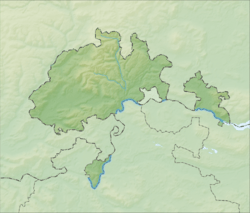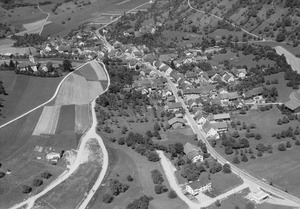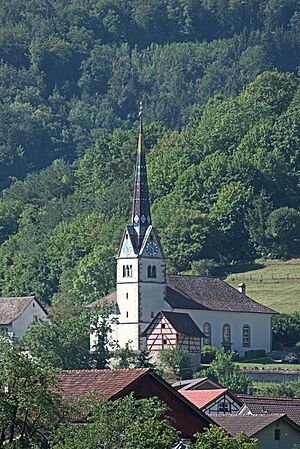Merishausen facts for kids
Quick facts for kids
Merishausen
|
||
|---|---|---|
 |
||
|
||
| Country | Switzerland | |
| Canton | Schaffhausen | |
| District | n.a. | |
| Area | ||
| • Total | 17.57 km2 (6.78 sq mi) | |
| Elevation | 533 m (1,749 ft) | |
| Population
(Dec 2020 )
|
||
| • Total | 877 | |
| • Density | 49.91/km2 (129.28/sq mi) | |
| Postal code |
8232
|
|
| Surrounded by | Bargen, Beggingen, Blumberg (DE-BW), Büttenhardt, Hemmental, Schaffhausen, Tengen (DE-BW) | |
Merishausen is a charming village, also called a municipality, located in the beautiful canton of Schaffhausen in Switzerland. It's a small community with a rich history and a peaceful setting near the German border.
Contents
History of Merishausen
Merishausen has a long history! It was first written about way back in the year 846. Back then, it was known by a slightly different name: Morinishusun.
Merishausen's Coat of Arms
Every town has a special symbol called a coat of arms. Merishausen's coat of arms is blue (Azure) and features a golden star (Mullet Or). This design is unique to the municipality.
Geography and Location
Merishausen covers an area of about 17.5 square kilometers (about 6.7 square miles). A large part of this area, about 65.6%, is covered by forests, making it a very green place. About 30.3% of the land is used for farming.
The village is located in the Schaffhausen district, right on the border with Germany. It sits along the Durach river, which was once an important route for trade between southern Germany and Switzerland.
Population and People
As of 2008, Merishausen had a population of 779 people. About 10% of the people living here are from other countries. Many of these foreign residents are from Germany, with others from Italy and various other nations.
Over the past ten years, the population of Merishausen has grown by about 7.4%. Most people in Merishausen speak German, which is the main language.
Age Groups in Merishausen
The population of Merishausen is made up of different age groups:
- Children and teenagers (ages 0–19) make up about 23.1% of the population.
- Adults (ages 20–64) make up about 61.2%.
- Seniors (over 64 years old) make up about 15.7%.
Education in Merishausen
Many adults in Merishausen have completed a good level of education. About 78.2% of people aged 25-64 have finished either upper secondary education or even higher education, like university.
In 2007, a small percentage of the population attended kindergarten (2.34%), primary school (7.72%), or different levels of secondary school (2.48% for lower level, 2.76% for higher level).
Historical Population Changes
The number of people living in Merishausen has changed over many years. Here's how the population has looked at different times:
| year | population |
|---|---|
| 1771 | 467 |
| 1798 | 674 |
| 1850 | 932 |
| 1900 | 632 |
| 1950 | 539 |
| 2000 | 644 |
Economy and Jobs
Merishausen has a very low unemployment rate, which means most people who want to work can find jobs. In 2005, many people worked in farming (the primary economic sector), with about 58 people employed in this area.
Some people also work in manufacturing (the secondary sector), and others work in services like shops and restaurants (the tertiary sector).
In 2008, there were 3 restaurants in Merishausen, and the hospitality industry employed 9 people. Many residents of Merishausen work outside the village, commuting to jobs in nearby towns.
Important Heritage Sites
Merishausen is home to an important historical building called the Pfarrscheune, or parish tithe barn. This building, located on Kirchgasse, is listed as a Swiss heritage site of national significance.
The village church was built in 1838. It stands on the same spot where an older church, first mentioned in 846 as St. Martins Church, once stood. The nearby tithing barn was built even earlier, in 1560, and today it is used as a farmhouse.
Weather in Merishausen
Merishausen experiences an average of about 130 days of rain or snow each year. The village typically receives about 996 millimeters (around 39 inches) of rain or snow annually.
The wettest month is usually June, with an average of 108 millimeters (about 4.2 inches) of rain or snow over about 11.7 days. May has the most days with precipitation (around 12.6 days), but with slightly less rain or snow overall. September is usually the driest month, with about 64 millimeters (around 2.5 inches) of precipitation over 11.7 days.
See also
 In Spanish: Merishausen para niños
In Spanish: Merishausen para niños






